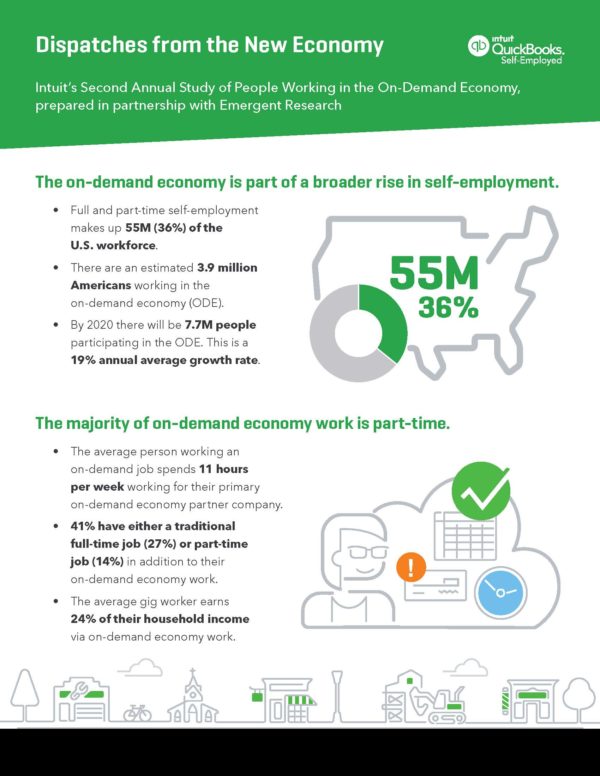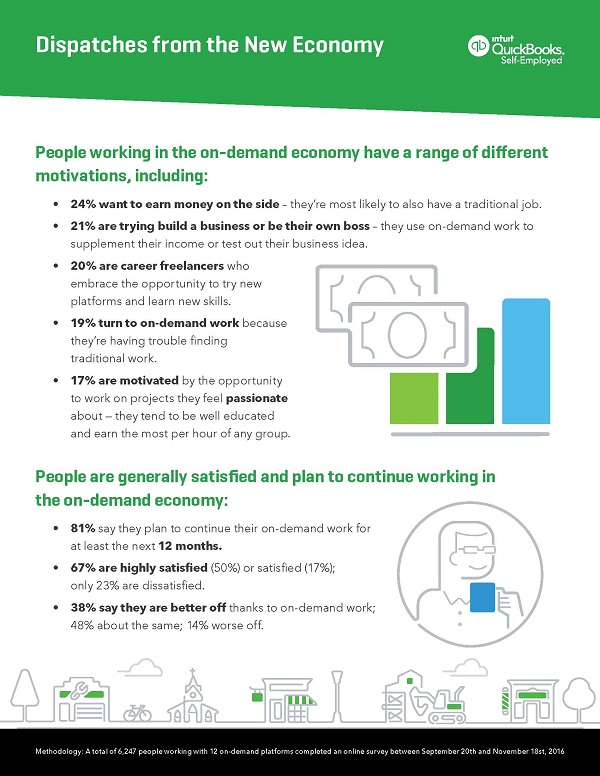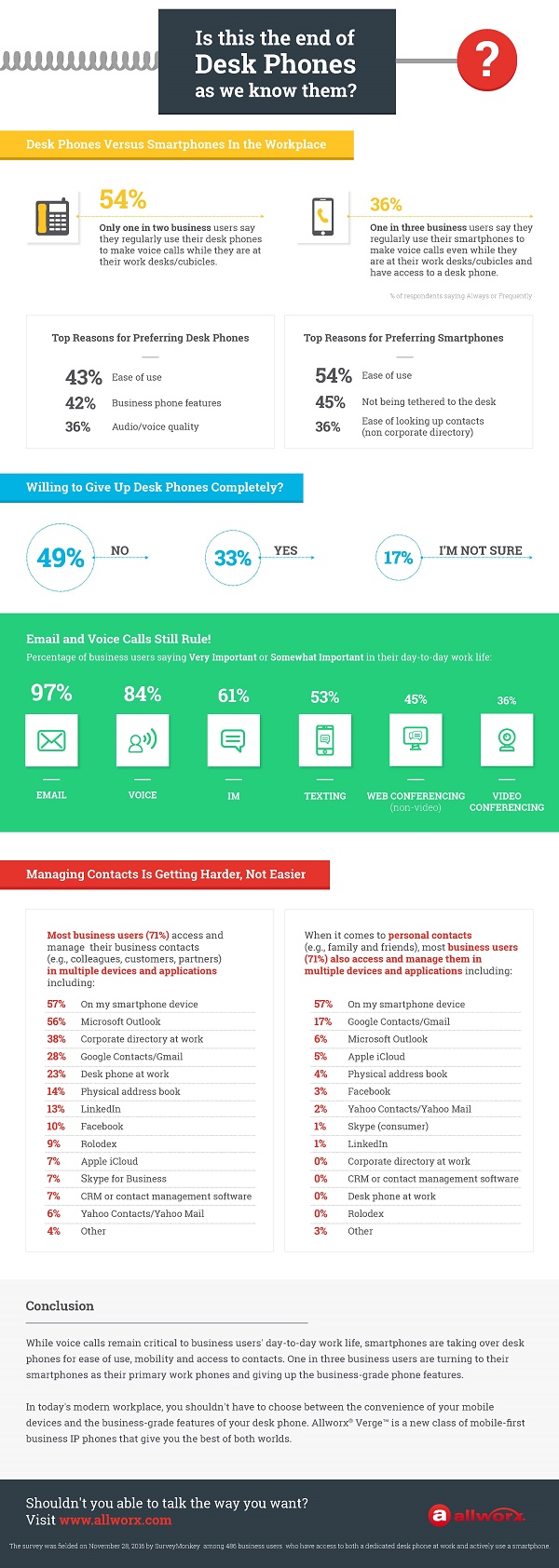12 Things Small Business Owners Need to Know
By Rieva Lesonsky
1—Dispatches from the New Gig Economy
Intuit, working with Emergent Research, has released its Second Annual Study of People Working in the On-Demand Economy. The study offers insight into today’s growing on-demand workforce.
Some key findings include:
- In 2016, part-time self-employment made up 36% (55 million) of the U.S. workforce
- The average on-demand worker spent 11 hours per week working for their primary on-demand employer
- 41% of on-demand workers had either a part-time or full-time job in addition to their on-demand work last year
- 19% of on-demand workers turned to on-demand work because they had trouble finding traditional work
- Only 23% of on-demand workers were dissatisfied with their work
For more insights, see the infographic below.


2—Customer Engagement
What is customer engagement and why does it matter? The folks at TimeTrade, which offers appointment scheduling software, says, “Creating a personalized, repeatable customer experience—every time you engage—is the key to long-term success.
Check out the infographic below to see what customers want, what frustrates them (and what happens when they’re not happy), why they buy, and how important customer experience is to generating brand loyalty.

3—5 Best Video Marketing Tools for SMB’s in 2017
Everyone is buzzing about video marketing. And according to Slidely, a social video creation platform, video marketing is no longer an option for small businesses—it’s an essential way for them to market their products and engage with customers, giving them new opportunities. Yet, Slidely says, many entrepreneurs struggle to build the momentum required for their products and services to stand out from the shadow of big brands with large budgets for marketing campaigns.
Slidely says these are the best video tools to help democratize advertising for SMBs to help put their businesses on the map.
PROMO by Slidely: PROMO is a new video creation solution for SMBs and marketers to create instant promotional videos with access to professional footage from Getty Images. The technology automatically curates videos and fuses licensed music and text based on your business. Simple customization tools allow users to personalize videos, add logos, download and publish directly across social media for as little as $20.
Magisto: Magisto is a smart video storytelling application that uses Emotion Sense Technology™ to automatically analyze and edit raw video footage and photos into movies, making video storytelling simple and easy to share. Magisto is available for iOS, Android, PC and the Web.
Animoto: Animoto’s online video maker makes it easy for anyone to create professional video. Its new Marketing Video Builder allows you easily turn your photos and video clips into share-worthy social videos using simple voice over, text control, and collage & layouts features. Animoto comes with Professional and Business plans.
Adobe Spark Video: Adobe Spark Video is a free online video editor for Adobe Spark users to easily create slideshows, presentations, ads, and stories using their own photos, videos, and music. Spark Video allows you to choose a template, add your own voice and content, and automatically adds cinematic motion for a seamless looking video. It is available for iOS, PC, and the web.
YouTube Director: YouTube Director is a new service that helps businesses make professional videos to connect with customers. Director onsite connects you with a trained filmmaker who’ll work with you over the phone to write your video script and then visit your business to shoot and edit your video. The entire process usually takes a few hours over 2 to 3 weeks.
4—The Best—and Worst Design Trends
Insight from Andy MacMillin, Creative Director at digital marketing agency Findsome & Winmore
Worst Trends
Hipster Design: If it feels like it should live in the rugged outdoors it should probably stay there in 2017. The “Hipster Aesthetic” has crept its way into many areas of design in recent years and let’s be honest—it was fun for a while. Badges, crests, and the playful use of classic words like “established,” “authentic” and “handcrafted” were all great ways of looking serious while not taking yourself seriously. Ah, Williamsburg…some of us will miss you.
The “Default” Sans Serif: Sans serifs will never go out of style and when done well and for the right purpose their use is classy, clean and impactful. But typography, particularly in the digital space, is vastly different today. There was once a time when quality serif fonts were rare jewels in digital design. That time is over. So let’s celebrate and make inspired choices rather than defaulting to routine.
Chalkboards: Often home to words like “handcrafted” or “farm-to-table,” the coffee shop/pub chalkboard should be wiped clean unless of course it’s actually in a pub or coffee shop.
Handwritten/Brushstroke Typography: Hand-scripted or brushed typography can be an appealing addition to many designs and is very much “having a moment,” but be careful when and how you use it as it’s rooted in the same earth from which hipster chic grew. What’s trendy today can quickly look dated tomorrow when people pack up their watercolors and move on.
The Template: Template website designs are simple and convenient, we get it. Especially for the startup small business owner who needs a clean, quick design to get a digital storefront up and running. But when the number of sites out there starts to look more and more like “Attack of the Clones,” it may be time to skip the template for something a little more custom—something that is inherently “your small business.” Trust us, it’s worth the investment to create a web presence that differentiates you from the crowd.
Best Trends
Irregular Grids: Though the perfectionists among us may beg to disagree, switching from a very rigid, mathematically measured grid design may actually be a clever move. Instead, a perfectly imperfect grid design on a website or ad can breathe life into the page and command attention.
Retro Design Made Modern: Specifically, 70s and 80s style is seeping back into the public consciousness, pushing past the more “classic,” early 1900s-1960s aesthetics we’ve seen in the past. Don’t worry, though—mullets and mustaches haven’t come back (yet).
Negative Space: An oldie but a goodie. A page that properly uses negative space to cleanly convey a message without clutter is almost always preferred for maximum, highly efficient impact.
Serif Fonts: As mentioned in our list of design trends to avoi, serif fonts are making a comeback in the digital realm. For years, designers avoided serifs simply out of necessity. There was a lack of quality serif fonts available to digital designers, which led to a natural preference for sans serifs. Over the years, however, a solid stable of high-quality serifs have been designed and are ready to mix up print ads, websites and branding well into the new year.
5—Retail Sales Finish Strong
Holiday retail sales during November and December increased 4% over 2015 to $658.3 billion, as a strengthening economy encouraged consumers to spend even more freely than expected, according to the National Retail Federation (NRF). The number includes $122.9 billion in non-store sales, which were up 12.6% over the year before.
The numbers exceeded NRF’s forecast of $655.8 billion, which would have been an increase of 3.6%. NRF had forecast online sales would grow between 7-10% to as much as $117 billion. The numbers exclude automobiles, gasoline stations and restaurants.
December was up 0.2 percent seasonally adjusted from November and 3.2 percent unadjusted year-over-year.
“These numbers show that the nation’s slow-but-steady economic recovery is picking up speed and that consumers feel good about the future,” NRF President and CEO Matthew Shay says. “Retail mirrors the economy. And while there might have been some bumps in the road for individual companies, the retail industry overall had a solid holiday season and retailers will work to sustain this in the year ahead.”
“There has been a lot of talk about online versus in-store retail in the past few months, but that comes from people who don’t realize that online and retail today are the same thing,” Shay says. “In the new distributed commerce world that allows consumers to buy any product, anytime, anywhere, it really doesn’t matter whether a customer shops in a company’s store or on its website or mobile app. It’s all retail. Today’s retailers sell to shoppers any way they want to buy.”
6—Privacy Day
Data Privacy Day is January 28. And by now, most of us know many SMB employees put themselves—and their sensitive data—in harm’s way because they’re unaware of the risks and proper security measures to take. In fact, in many data breach cases, human error is often the culprit.
Dave Wagner, CEO of security software company ZixCorp, says a small business looking to safeguard its company from the threats its employees unknowingly pose should take the following steps:
Invest in employee education and training. All employees need to have strong passwords protecting their devices, including cellphones and laptops. Also, encourage employees to only use Wi-Fi networks they are familiar with to avoid an information sharing mishap. Consider signing up for a security webinar or training session, so all employees can get up-to-speed on simple ways to protect themselves from a data breach.
Set up safeguards, such as Data Loss Prevention technology, to protect employees from themselves. You can set up software that will scan outbound mail for possible red flags. If there’s a cause for concern, the software will quarantine the message and check in with the administrator to confirm they want this information delivered. That way, employers and employees can rest easy knowing sensitive information—like addresses, credit card information, etc.—is safe.
Create a system where securely transferring data does not take extra steps. To ensure your employees adopt data-protecting habits, you’ll want to make it as easy for them as possible. Consider a solution that works seamlessly with your company’s current devices and policies, so your employees can spend their time growing your small business, instead of risking it.
7—One Size Doesn’t Fit All with Employee Promotion Plans
A new report from Clutch, a B2B ratings and reviews firm, says HR managers are likely to be facing challenges when trying to update their company’s formal reviews plan and meet all of their employees’ expectations simultaneously. A recent survey conducted by Clutch reveals the factors on which employees prefer to be evaluated for a raise vary widely—depending on age, gender, level of experience, and the size of the company they work for.
According to the survey, women and Millennials prefer (more often than men, GenXers, or Baby Boomers) to be evaluated based on behaviors and attitudes. Baby Boomers are more likely than those in other generations to want to be evaluated based on tenure and seniority.
Clutch says traditionally, HR professionals have based promotions on strictly quantitative metrics to determine whether an employee receives a raise or promotion. But rather than attempting to boil an employee’s achievements down to a score, HR managers are now looking to more holistic means of providing evaluation feedback.
However, on closer analysis, this holistic approach to feedback, evaluation, and promotion can be more challenging as the size of a company increases, and managers and HR professionals may not be able to provide detailed, personalized feedback to every employee. This is a main reason why enterprise organizations are typically slow to adopt new strategies for employee promotions.
At small businesses with fewer than 50 employees, 45% of employees prefer that behaviors and attitudes, rather than measurable outputs, be the primary basis for a raise.
In addition to age and the size of a company, gender is a great divider when it comes to how an employee wants to be evaluated for a promotion and raise. Nearly half of women employees (45%) prefer to be evaluated on their behaviors and attitudes as opposed to measurable outputs, compared to 37% of men.
According to Clutch, the survey strongly suggests that while managers can get a general sense of the qualities their employees most value when being considered for a raise, it is a significant challenge to create one system that pleases every employee at a company. Managers should instead attempt to include all these factors when considering an employee for promotion, and be transparent and consistent in the process.
8—Credit Complaints
Did you know that credit reporting is the number one complaint in the CFPB complaint database? LendEDU reports the latest stats from the Consumer Financial Protection Bureau (CFPB) which shows in 2016 there were 186,494 complaints filed with the CFPB—23% of them were filed under the Credit Reporting product. Consumers complained about credit reporting more often than mortgages, debt collection, bank accounts or services, credit cards, consumer loans, money transfers, payday loans, prepaid cards, or virtual currency.
You can find more details on their blog.
9—Are Desk Phones Dead?
Allworx® Corp., recently introduced several new products including, Allworx Verge™, a new class of mobile-first IP phones for businesses, System Software version 8.2, Allworx Reach™ version 3.0 (for iOS and Android) and Allworx Interact™ Professional version 3.0 to support the latest mobility integration features available with Verge.
According to the company, as smartphones have become the central hubs for business users to manage communications and store contacts, traditional business desk phones are increasingly becoming isolated, less-useful devices. In fact, according to a new third-party survey of 486 U.S. workers with access to both a dedicated work desk phone and a smartphone, only one in two regularly use their desk phones for making voice calls, and one in three prefer to use their smartphones to make voice calls—even when they have easy access to a desk phone. One in three say they are willing to give up desk phones at work entirely.
Check out the infographic below for more information.

Cool Tools
10—Easier Payment Solution Introduced
Samsung Electronics America, Inc. and Total Merchant Services, Inc. announced the availability of Groovv POS Flex, a comprehensive and easy to use point-of-sale (POS) solution designed specifically for SMBs. Groovv POS Flex features a Samsung Galaxy Tab E 9.6” Tablet and an EMV-compliant and NFC-enabled payment processing device, which are pre-programmed with a full suite of software for inventory management, reporting and integrated marketing. The full system can be set up and deployed within minutes of unpacking the product.
Groovv POS Flex is a mobile alternative to countertop devices, with the detachable Samsung Galaxy Tab E 9.6” and payment devices, as well as a foldable swivel stand that enables staff to process customer orders and payments conveniently from the countertop or while roaming. In addition, the system connects wirelessly to peripherals, including a cash drawer-receipt printer, barcode scanner and kitchen printer, so retailers can fully customize their setups to match their particular needs.
Key features Include:
- Intuitive software:Software built into Groovv POS provides sophisticated reporting tools that let merchants monitor financials, view sales history, identify sales trends and utilize embedded marketing tools.
- EMV compliant and NFC-enabled: EMV-compliant and NFC-enabled payment device accepts chip cards, Samsung Pay and other NFC mobile payment solutions.
- White glove activation and support:Provides fast, out-of-the-box hardware and software setup with convenient pre-loaded inventory options.
- Powerful back office and reporting:Includes advanced inventory management, streamlined administration tools and back-office reporting.
- Sophisticated inventory management:Offers customizable categories to keep inventory organized, simplified controls for item management, and inventory alerts to note what’s running low.
- Intuitive user experience:Features stress-free software with an intuitive interface and easy touchscreen navigation.
- Integrated marketing solutions: Enables consumer loyalty programs, engagement tools, and enhanced message management to increase customer visits and sales.
Groovv POS Flex is available now from Total Merchant Services sales partners as well as direct from the company. Options include free placement of the solution (with processing agreement) or customer purchase of the hardware (pricing may vary). To see if you qualify for free placement, contact Total Merchant Services at (888) 610-1025.
11—Improving Financial Management
Capital One Spark Business just announced two new strategic partnerships with Bill.com and Gusto to build and deliver better financial management, HR and cash flow tools designed for a small business.
The partnerships will simplify the way small businesses access and manage their cash flow, seamlessly integrate HR into business processes, and expand Spark Business’ growing suite of financial products, tools and experiences designed to empower small businesses.
The company says this collaboration is part of its long-term plan to build a broad ecosystem of financial technology partners, enabling seamless yet secure transmission of financial data and activity. Ultimately the experience will provide a smoother, faster, more connected and comprehensive view of a small business’ cash flow and projected financial conditions.
Bill.com helps top banks and accounting firms cement longer, richer relationships with small business owners and Gusto provides an all-in-one HR, payroll and benefits platform utilizing technology to simplify the HR and payroll management process.
12—Scheduling Interviews
ScheduleOnce, a leading scheduling automation solution, recently acquired Reschedge, a leading algorithmic scheduling engine for interviews. With this acquisition, ScheduleOnce will leverage its platform to offer an end-to-end solution for interview scheduling through all phases of the talent acquisition lifecycle.
As we all know, recruiting the right people is essential to the success of your small business. And while the search for top talent has intensified, the process of coordinating interviews remains an obstacle for everyone involved. d candidates alike.
With its patent-protected technology, Reschedge offers a solution designed specifically to overcome the pains of interview scheduling. A sophisticated algorithm combines interview requirements, hiring manager availability, and resource constraints to offer the best possible scheduling options. Reschedge handles all situations, from simple one-on-ones to panels and all-day, sequenced interviews.
Reschedge SaaS subscriptions are now immediately available for purchase from ScheduleOnce.






